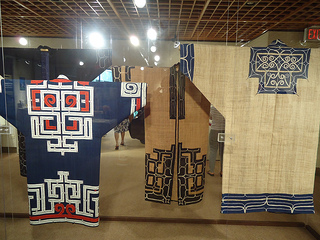Difference between revisions of "Ainu textiles"
From SamuraiWiki
Jump to navigationJump to searchm (LordAmeth moved page Attus to Ainu textiles: Broader topic to avoid tiny stub articles) |
|||
| Line 1: | Line 1: | ||
[[File:Ainu-robes.jpg|right|thumb|320px|Ainu robes on display at the East-West Center in Honolulu]] | [[File:Ainu-robes.jpg|right|thumb|320px|Ainu robes on display at the East-West Center in Honolulu]] | ||
| − | [[Ainu]] bark | + | Traditional [[Ainu]] garb includes bark cloth robes called ''attus'', and embroidered cotton robes called ''ruunpe'' and ''ciciri'', as well as several other types of garments. |
| + | |||
| + | Ainu robes can be found in many anthropological or natural history collections around the world; while these robes are still made and used in Ainu communities, there are also Ainu today both in [[Hokkaido|Hokkaidô]] and in the [[Kanto|Kantô]] who work to recreate old traditional motifs and forms. It can take up to a full year to produce a traditional garment; each embroidered design must be sewn three times over. | ||
{{stub}} | {{stub}} | ||
Revision as of 12:14, 4 November 2015
Traditional Ainu garb includes bark cloth robes called attus, and embroidered cotton robes called ruunpe and ciciri, as well as several other types of garments.
Ainu robes can be found in many anthropological or natural history collections around the world; while these robes are still made and used in Ainu communities, there are also Ainu today both in Hokkaidô and in the Kantô who work to recreate old traditional motifs and forms. It can take up to a full year to produce a traditional garment; each embroidered design must be sewn three times over.
References
- Gallery labels, "Ainu Treasures," East-West Center Gallery, Feb 2013.
